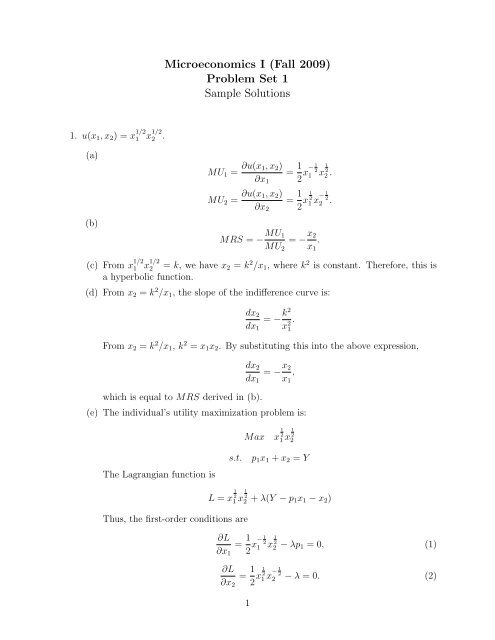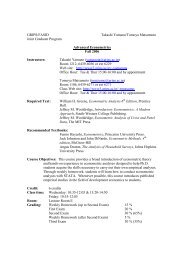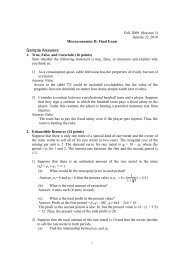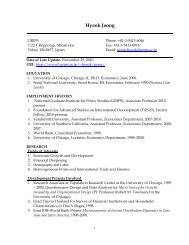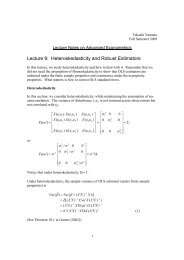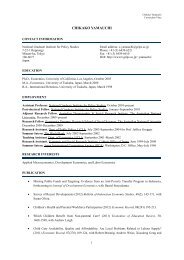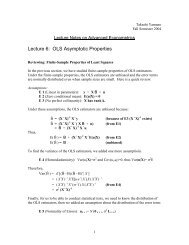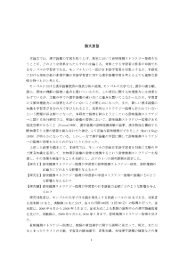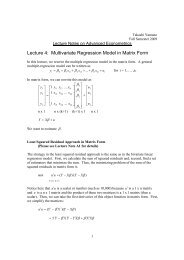Microeconomics I (Fall 2009) Problem Set 1 Sample Solutions
Microeconomics I (Fall 2009) Problem Set 1 Sample Solutions
Microeconomics I (Fall 2009) Problem Set 1 Sample Solutions
Create successful ePaper yourself
Turn your PDF publications into a flip-book with our unique Google optimized e-Paper software.
<strong>Microeconomics</strong> I (<strong>Fall</strong> <strong>2009</strong>)<br />
<strong>Problem</strong> <strong>Set</strong> 1<br />
<strong>Sample</strong> <strong>Solutions</strong><br />
1. u(x 1 , x 2 ) = x 1/2<br />
1 x 1/2<br />
2 .<br />
(a)<br />
(b)<br />
MU 1 = ∂u(x 1, x 2 )<br />
∂x 1<br />
= 1 2 x− 1 2<br />
1 x 1 2<br />
2 .<br />
MU 2 = ∂u(x 1, x 2 )<br />
∂x 2<br />
= 1 2 x 1 2<br />
1 x − 1 2<br />
2 .<br />
MRS = − MU 1<br />
MU 2<br />
= − x 2<br />
x 1<br />
.<br />
(c) From x 1/2<br />
1 x 1/2<br />
2 = k, we have x 2 = k 2 /x 1 , where k 2 is constant. Therefore, this is<br />
a hyperbolic function.<br />
(d) From x 2 = k 2 /x 1 , the slope of the indifference curve is:<br />
dx 2<br />
= − k2<br />
.<br />
dx 1<br />
From x 2 = k 2 /x 1 , k 2 = x 1 x 2 . By substituting this into the above expression,<br />
which is equal to MRS derived in (b).<br />
x 2 1<br />
dx 2<br />
dx 1<br />
= − x 2<br />
x 1<br />
,<br />
(e) The individual’s utility maximization problem is:<br />
Max x 1 2<br />
1 x 1 2<br />
2<br />
The Lagrangian function is<br />
s.t.<br />
p 1 x 1 + x 2 = Y<br />
Thus, the first-order conditions are<br />
L = x 1 2<br />
1 x 1 2<br />
2 + λ(Y − p 1 x 1 − x 2 )<br />
∂L<br />
∂x 1<br />
= 1 2 x− 1 2<br />
1 x 1 2<br />
2 − λp 1 = 0, (1)<br />
∂L<br />
∂x 2<br />
= 1 2 x 1 2<br />
1 x − 1 2<br />
2 − λ = 0. (2)<br />
1
By dividing (1) by (2), we have x 2 /x 1 = p 1 , or x 2 = p 1 x 1 . By substituting this<br />
into the budget constraint, the demand functions for goods 1 and 2 are given by<br />
x 1 = Y<br />
2p 1<br />
,<br />
x 2 = Y 2 .<br />
Note that the demand function for good 1 is again hyperbolic.<br />
2. u(x 1 , x 2 ) = min{2x 1 , x 2 }.<br />
(a) (Omitted. Please refer to Figure 4.4 (b) on p. 82 in the textbook for the case of<br />
u(x 1 , x 2 ) = min{x 1 , x 2 }.)<br />
(b) Let us consider a point (x 0 1, x 0 2) on x 2 = 2x 1 . Then, x 0 2 = 2x 0 1 (or equivalently<br />
x 0 1 = x 0 2/2) holds.<br />
i. (x 1 , x 2 ) = (x 1 , x 0 2), x 1 > x 0 2/2: In this case, from 2x 1 > x 0 2, we have<br />
u(x 1 , x 2 ) = min{2x 1 , x 0 2} = x 0 2. An increase in x 1 , therefore, does not raise<br />
utility. Thus, MU 1 = 0. On the other hand, MU 2 = ∂u(x 1 , x 2 )/∂x 2 =<br />
∂x 2 /∂x 2 = 1. Thus, MRS = −MU 1 /MU 2 = 0.<br />
ii. (x 1 , x 2 ) = (x 0 1, x 2 ), x 2 > x 0 2: Since x 2 > x 0 2 = 2x 0 1, u(x 0 1, x 2 ) = min{2x 0 1, x 2 } =<br />
2x 0 1. From ∂u(x 1 , x 2 )/∂x 2 = ∂(2x 1 )/∂x 2 = 0, MU 2 = 0. Besides, from<br />
∂u(x 1 , x 2 )/∂x 1 = ∂(2x 1 )/∂x 1 = 2, MU 1 = 2. Therefore, MRS = −2/0 =<br />
−∞.<br />
iii. (x 1 , x 2 ) = (x 0 1, x 0 2): In this case, MRS is not defined.<br />
(c) Rearranging the budget constraint, p 1 x 1 + x 2 = Y , gives x 2 = Y − p 1 x 1 . From the<br />
shape of indifference curves, it is inferred that utility is maximized on x 2 = 2x 1 .<br />
Solving the simultaneous equations,<br />
x 1 (p 1 ) =<br />
x 2 (p 1 ) =<br />
Y<br />
p 1 + 2 ,<br />
2Y<br />
p 1 + 2 .<br />
You already know how to depict the graph of x 1 (p 1 ).<br />
3. u(x 1 , x 2 ) = x 1 + x 2 .<br />
(a)<br />
MRS = − MU 1<br />
MU 2<br />
= −1.<br />
(3)<br />
2
(b) By rearranging the budget constraint, x 2 = Y − p 1 x 1 . Note that the slope of the<br />
budget line is −p 1 while the slope of indifference curves is −1.<br />
i. If p 1 > 1, utility is maximized at (x 1 , x 2 ) = (0, Y ). That is, the whole income<br />
is spent on good 2. This is because the individual is indifferent between goods<br />
1 and 2, and because the price of good 2 (p 2 = 1) is lower than that of good<br />
1 (p 1 > 1).<br />
ii. By contrast, if p 1 < 1, the individual spends the whole income on good 1.<br />
The demand for good 1 is thus x 1 = Y/p 1 .<br />
iii. Lastly, if p 1 = 1, the prices of goods 1 and 2 are identical. Therefore, the<br />
demand for good 1 could be any amount between 0 and Y.<br />
In summary, the demand function for good 1 is:<br />
⎧<br />
⎨ Y/p 1 if p 1 < 1<br />
x 1 (p 1 ) = 0 if p 1 > 1<br />
⎩<br />
any value between 0 and Y if p 1 = 1<br />
3


